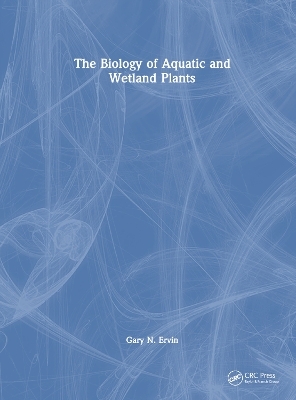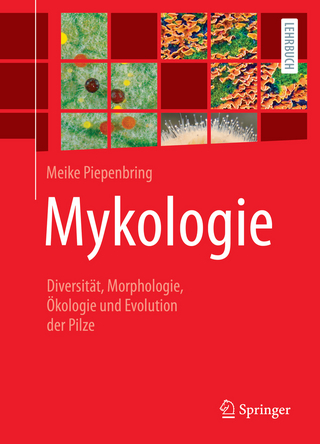
The Biology of Aquatic and Wetland Plants
Crc Press Inc (Verlag)
978-1-4822-3204-2 (ISBN)
- Titel z.Zt. nicht lieferbar
- Versandkostenfrei innerhalb Deutschlands
- Auch auf Rechnung
- Verfügbarkeit in der Filiale vor Ort prüfen
- Artikel merken
Aquatic plants play a critically important role in maintaining ecosystem health. They are natural biological filters in freshwater and estuarine wetlands; they contribute to the reproductive success of many organisms, some of which are harvested for food; they assist in flood control; and they are prominent elements in the aesthetics and recreational use of freshwater and estuarine habitats. Despite this globally recognized importance, wetlands have faced and continue to face threats from the encroachment of human activities. The Biology of Aquatic and Wetland Plants is a thorough and up-to-date textbook devoted to these plants and their interactions with the environment. The focus is on botanical diversity from the perspective of evolutionary relationships, emphasizing the role of evolution in shaping adaptations to the aquatic environment. By incorporating recent findings on the phylogeny of green plants, with special emphasis on the angiosperms, the text is broadly useful for courses in plant biology, physiology, and ecology. Additionally, a chapter on population biology and evolutionary ecology complements the evolutionary backdrop of hydrophyte biology by examining the details of speciation and applications of modern genetic approaches to aquatic plant conservation.
Key Features
• Synthesizes recent and seminal literature on aquatic and wetland plants
• Emphasizes evolutionary history as a factor influencing adaptations to the wetland environment
• Provides a global perspective on plant diversity and threats facing wetland ecosystems
• Highlights research needs in the field of aquatic and wetland plant biology
• Includes 280 figures, with more than 300 color photographs, and 41 tables to provide ease of access to important concepts and information
Gary Ervin received his B.S. (1996) and Ph.D. (2000) in Biological Sciences from the University of Alabama, in Tuscaloosa. During his undergraduate and doctoral research, he studied the ecology of freshwater wetland plants, publishing several papers on the ecology of the rush, Juncus effusus. After completing his doctoral studies, Dr. Ervin held a postdoctoral research position in the Department of Entomology at the University of Arkansas, Fayetteville. While in Arkansas, he studied plant defense responses to insect herbivores, with an emphasis on oxidative biochemistry of plant-insect interactions. Dr. Ervin began his present faculty position in the Department of Biological Sciences at Mississippi State University in 2001. His research program at Mississippi State University has been focused on better understanding mechanisms influencing plant colonization and persistence, including research on species invasions. Dr. Ervin and his collaborators have worked with invasive plants in forests, wetlands, and prairies, but also have studied interactions between plants and insect biocontrol agents. During his two decades on the faculty at Mississippi State, Dr. Ervin has taught courses on plant ecology, invasion ecology, plant biology, aquatic botany, and global change, and he has published dozens of scientific articles on both terrestrial and wetland plant ecology. Dr. Ervin is a long-time member of the Society of Wetland Scientists (SWS) and is certified as a Professional Wetland Scientist by that organization. At the time of writing this text, he served as a member of the executive committee of the SWS South Central Chapter, on the mentoring committee of the SWS Latin American and Caribbean student mentoring program (HumMentor), and on the SWS education section editorial board for the online resource, Foundations in Wetlands Science.
Chapter 1. Overview1.1 Importance of Aquatic and Wetland Plants
1.2 What This Book is About
1.2.1 Wetland Habitats Defined
1.2.2 Aquatic and Wetland Plants Defined
1.3 Growth Forms and Zonation of Aquatic and Wetland Plants
1.3.1 Overview of Plant Anatomy
1.3.2 Emergent Plants
1.3.3 Floating-leafed Plants
1.3.4 Submersed Plants
1.3.5 Free-Floating Plants
1.3.6 A Few Exceptions to the Above Classification
1.3.7 Zonation
Chapter 2. Evolutionary Relationships Among Aquatic and Wetland Plants
2.1 Why evolutionary history is important
2.1.1 The Disorderliness of Taxonomic Organization
2.1.2 Reconstructing Evolutionary Trees
2.2 The Green Plants as a Starting Point
2.2.1 Charophytes
2.2.2 Early Diverging Embryophytes – the Bryophyta
2.2.3 Non-Angiosperm Tracheophytes
2.3 Evolution and Diversification of the Angiosperms
2.3.1 Nymphaeales
2.3.2 Monocots
2.3.3 Magnoliidae
2.3.4 Ceratophyllales
2.3.5 Eudicots
2.4 Truly Aquatic Plants
2.5 Taxonomic Diversity of Mangrove Species
Chapter 3. Wetland Ecosystems and Plant Diversity 3.1 Major Wetland Types
3.2 Global Tour of Wetlands and Plant Diversity
3.2.1 The Pantanal, Brazil
3.2.2 The Iberá Wetlands, Argentina
3.2.3 Congo River Swamps, Republic of the Congo & Democratic Republic of the Congo
3.2.4 Okavango Delta, Botswana
3.2.5 Kakadu Wetlands, Australia
3.2.6 Whangamarino Wetland, New Zealand
3.2.7 The Sundarbans, India & Bangladesh
3.2.8 Qinghai-Tibet Plateau Wetlands, China
3.2.9 Kolkheti Lowlands, Georgia
3.2.10 Doñana National Park, Spain
3.2.11 Boreal Peatlands, Canada
3.2.12 The Everglades, Florida, United States
3.2.13 Bottomland Forests, Mississippi, United States
3.3 Global Patterns of Wetland Plant Diversity
3.4 Global Threats to Wetland Integrity
Chapter 4. Hydrology
4.1 Overview of Wetland Hydrology
4.2 Quantifying Hydrology with a Hydrologic Budget
4.2.1 Precipitation and Interception
4.2.2 Overland Flows
4.2.3 Soil Water Flow and Groundwater Flow
4.2.4 Evapotranspiration
4.2.5 Change in Storage
4.2.6 Hydroperiod Integrates the Hydrology Across Time
Chapter 5. Critical Features of the Aquatic Environment
5.1 Key Features of Water as a Medium for Plant Life
5.1.1 Temperature and density relations of water
5.1.2 Water as a Solvent
5.2 Patterns of Light Availability
5.2.1 Influence of Water on Light
5.2.2 Influence of Dissolved and Suspended Materials on Light
5.3 Carbon Dioxide Availability in the Water
5.4 Oxygen Availability in the Water and Sediments
5.4.1 Patterns of Oxygen in the Water and Sediments
5.4.2 Redox Chemistry
5.4.3 Anaerobic Microbial Metabolism
Chapter 6. Adaptations for Life in the Aquatic Environment6.1 Critical Limitations for Life in the Water
6.2 Anaerobic/Hypoxic Physiology
6.2.1 "Energy Crisis" Metabolism
6.2.2 Ethylene Production and Signaling
6.3 Aerenchyma
6.4 Aeration Systems
6.4.1 Aeration via Positive Pressure
6.4.2 Aeration via Negative Pressure
6.5 Radial Oxygen Loss
6.6 Root Adaptations
6.7 Rapid Shoot Elongation
6.8 Heterophylly
6.8.1 Factors Influencing Heterophylly
6.8.2 Benefits of Heterophylly
6.9 Modifications to Photosynthetic Metabolism
6.9.1 C4 Photosynthesis
6.9.2 CAM or AAM Photosynthesis
6.9.3 Use of Bicarbonate
6.9.4 Switching Among Photosynthetic Pathways and Intermediate Phenotypes
Chapter 7. Plant Nutrition and Sediment Biogeochemistry
7.1 Plant Nutrition
7.2 Carbon, Hydrogen, and Oxygen as Essential Nutrients
7.3 Methanogenesis and the Carbon Cycle
7.4 Soil Macronutrients
7.4.1 Nitrogen
7.4.2 Phosphorus
7.4.3 Other Soil Macronutrients
7.5 Soil Micronutrients
7.5.1 Influence of Redox Chemistry on Iron and Manganese
7.5.2 Other Soil Micronutrients
7.6 Plant Adaptations for Nutrient Access
7.6.1 Nitrogen Fixing Symbionts
7.6.2 Mycorrhizae
7.6.3 Carnivorous Plants
Chapter 8. Reproduction
8.1 Plant Reproduction in the Context of Life History
8.2 Sexual Reproduction in Plants
8.2.1 Points of Potential Modification
8.2.2 Pollination within Closed Flowers – Cleistogamy
8.2.3 Pollination of Open Flowers
8.2.3.1 Self-Pollination within Open Flowers - Autogamy
8.2.3.2 Self-Pollination between Open Flowers - Geitonogamy
8.2.3.3 Pollination by Animals
8.2.3.4 Pollination by Wind
8.2.3.5 Pollination by Water
8.2.3.6 Pollination above the Water Surface
8.2.3.7 Pollination on the Water Surface
8.2.3.8 Pollination below the Water Surface
8.2.4 Compatibility, Inbreeding, and Inbreeding Avoidance
8.2.5 Fruit and Seed Development & Dispersal
8.2.6 Dormancy and Germination
8.2.7 Regeneration Niche
8.3 Clonal Propagation in Aquatic and Wetland Plants
8.3.1 Multiple Functionality of Asexual Propagules
8.3.2 Types of Asexual Propagules
8.3.2.1 Modified Buds
8.3.2.2 Shoot Fragments
8.3.2.3 Modified Shoots
8.3.2.4 Modified Shoot Bases
8.3.2.5 Modified Roots
8.4 Balancing Sexual vs. Asexual Reproduction
Chapter 9. Population Biology & Evolutionary Ecology
9.1 Population Biology in the Context of Evolution
9.2 Population Biology
9.2.1 Density-Independent Population Growth
9.2.2 Density-Dependent Population Growth
9.2.3 Age- or Stage-Based Approaches
9.3 Metapopulations: Populations of Populations
9.4 Metapopulations, Local Adaptation, and Speciation
9.4.1 Mechanisms of Divergence
9.4.2 Examples from Aquatic and Wetland Ecosystems
9.5 Evolutionary ecology
9.5.1 Conservation Genetics
9.5.2 Hybridization
Chapter 10. Species Interactions10.1 Interactions in the Context of Life History
10.2 Competition (- -)
10.2.1 A Formal Construct for Studying Competition
10.2.2 Quantifying Competition
10.3 Amensalism (- 0)
10.4 Allelopathy in Aquatic and Wetland Plants
10.4.1 Interplay between Allelopathy and Competition
10.4.2 Quantifying Allelopathy in Wetlands
10.5 Commensalism (+ 0)
10.6 Exploitative Interactions (- +)
10.6.1 Herbivory
10.6.2 Parasites and Pathogens of Aquatic and Wetland Plants
Chapter 11. Plants in the Context of Wetland Ecosystems
11.1 Putting it all Together
11.2 Succession
11.3 Disturbance
11.4 Mitigation of Eutrophication by Wetland Plants
11.5 Climate Change and Wetland Carbon Storage
| Erscheinungsdatum | 20.04.2023 |
|---|---|
| Zusatzinfo | 42 Tables, black and white; 137 Line drawings, color; 40 Line drawings, black and white; 104 Halftones, color; 241 Illustrations, color; 40 Illustrations, black and white |
| Verlagsort | Bosa Roca |
| Sprache | englisch |
| Maße | 210 x 280 mm |
| Gewicht | 890 g |
| Themenwelt | Naturwissenschaften ► Biologie ► Botanik |
| Naturwissenschaften ► Biologie ► Ökologie / Naturschutz | |
| Technik ► Umwelttechnik / Biotechnologie | |
| ISBN-10 | 1-4822-3204-9 / 1482232049 |
| ISBN-13 | 978-1-4822-3204-2 / 9781482232042 |
| Zustand | Neuware |
| Informationen gemäß Produktsicherheitsverordnung (GPSR) | |
| Haben Sie eine Frage zum Produkt? |
aus dem Bereich


